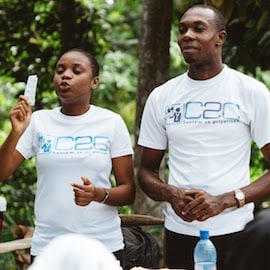There’s No App to Fix Farming – A Lifelong Smallholder Shares What Social Business is Getting Wrong
As early as I can remember, probably from around 5 years old, like millions of other mothers across Africa, my mother would strap me to her back using a leso (a colourful, multipurpose shawl-like garment common in East Africa) and head to our 4-acre farm on the slopes of the Nyandarua ranges in Kenya. This was the beginning of what has become a lifelong fascination with the small farm.
Years later, together with my co-founder John Oroko, who was also born and brought up in a smallholder family in the western part of Kenya, I started Selina Wamucii, a business-to-business fresh produce company that integrates smallholder farmers into local and global supply chains.
Two years down the line and having sold smallholder-sourced produce locally and in 17 countries, a picture gradually emerged, one that is not so simple, if not inconsistent with the picture currently painted out there in matters of small-scale farming.
Below are some observations and insights gathered along the way. They are meant to be candid and in no way antagonistic. My hope is that smallholder farming can be fixed and optimized so it becomes a viable source of livelihood for those who rely on it. My views are specific to Kenya.
Poor Policy Has Impoverished Smallholder Farmers
Some laws, policies and regulatory frameworks have been or are coming into place with far more ramifications on smallholder farmers than erratic rain, degraded soil, climate change, access to finance or lack of good agricultural practices.
In 2013, Kenya enacted the Agriculture, Fisheries and Food Authority Act 2013 (AFFA), which prohibits exports of raw agricultural produce such as macadamia and cashew nuts. The justification of this act back then was buried somewhere inside the “value addition” and “industrialization” buzzwords – at the expense of the farmer.
The result is that, in less than three years, the buying price of unprocessed macadamia nuts dropped from KES 150 (US $1.50) to KES 70 (US $0.70) per kilo that is now offered by processors. The price of unprocessed cashew nuts dropped from KES 70 (US $0.70) to as low as KES 20 (US $0.20) a kilo. The farmers have started uprooting cashew nut trees. Just like that, over 60,000 smallholder farmers have become poorer.
Another example is coffee. In Kenya, the law is such that it sets a minimum threshold for production of 2,000 metric tonnes of clean coffee per year for one to participate at the coffee auction (where most of the country’s coffee is sold). This minimum amount cannot be met realistically by any small-scale farmer, which obligates the farmer to engage the services of an agent who, as a matter of fact, is a representative of the coffee buyer. This obviously leads to a conflict of interest and price fixation issues. No amount of good rain or good agricultural practices can save the poor farmer from being underpaid and exploited at the hands of deep-pocketed coffee-buy conglomerates that lobby and influence self-serving policy.
As it currently stands, smallholder farmers lack the voice and power to influence policy. Strengthening the lobbying muscle of smallholder farmers has a good chance of improving their lives.
Oversold Impact is the New Normal
A NextBillion article here refers to an article in The Economist stating that a randomized controlled trial (RCT) in India found that installing minigrids in small villages with no electricity resulted in little or no positive impact on the villagers’ lives. I am not surprised. In my village, most of the people are awake by 6 in the morning and by 9 p.m. the village is largely asleep. A two-hour lighting solution (at night) would in no way contribute to the productivity and efficiency of the farmer during the 12 hours of daylight, when they do their farmwork. So it would definitely have little if any impact on the farmer’s life.
Yet, household solar-based solutions are currently being overpitched among rural smallholder farmers across Kenya and Africa. I recently visited a smallholder farmer and was shocked to learn that the small, low-resolution solar-powered TV he was watching was sold as a package consisting of a radio and a couple of bulbs, all at an unbelievable price of KES 53,625 (US $526). This farmer barely makes US $1,000 a year, meaning this solar-powered product is not only far too expensive for him but also offers very little value in terms of increasing productivity. Ironically, this farmer’s home is 290 metres away from a power transformer.
Despite the fact that access to electricity is key to increasing agricultural productivity, it is worrying that smallholder farmers are made to do with marginal solar products in the name of innovation. From irrigation to cold storage to powering agricultural equipment like incubators and pumps – this is where it will make a difference for the smallholder farmers. While solar is great, marginal solar-based solutions – however ingenious the design or good the intention – are not going to cut it.
And this phenomenon is not limited to solar products. You will find all manner of highly pitched solutions that are supposedly the magic bullet to cold storage, irrigation or access to water for smallholder farmers. Unfortunately, these problems will not be fixed by an app, this solar product or that mobile-based solution as many people in the space hope. Take cold storage for example. We source mangoes from Makueni county (86 kilometres southeast of Nairobi), which produces thousands of tonnes of mangoes every year. Most of these mangoes go to waste because there are no cold room facilities, and local makeshift improvisations can barely suffice to keep mangoes cool given the amount of heat generated by the mangoes themselves. To fix the cold chain problem, the farmers need access to actual, proper-functioning cold rooms that can accommodate all the produce and keep it in the required temperature range, reliably.
Middlemen Aren’t the Problem
One of the most enduring consistencies in the smallholder agriculture space is misleading information. Powerful stories that don’t paint the true picture are often woven out of this information. These powerful stories sometimes influence action that is not necessarily in the best interest of smallholder farmers.
A good example is the often-demonized middlemen or so-called brokers in the smallholder agriculture chain. The fragmented nature of smallholder farming means that these middlemen provide a very important service in the broken value chain while taking on a considerable amount of risk. Middlemen aggregate small volumes of produce from many farmers in villages like ours. These small volumes are combined to make a large enough volume that the middlemen then deliver to the market. The middlemen invest in all the resources required to facilitate this, including sourcing, transportation and finding the market. Without them, a smallholder farmer producing 200 kilograms of mangoes will never sell this product in a market in Nairobi, for instance – and the mangoes cannot be sold within the village because everyone there already has them. In addition, most middlemen pay farmers upfront and take all the risk right from the farm to the market. So if something happens along the way and the produce goes bad, the middlemen will have to absorb the loss – and the same thing happens if there is a drastic market price drop. When we blindly demonize middlemen, we turn a key farmer ally into an adversary.
Going against the grain and wisdom out there, Selina Wamucii Ltd. decided to work with vetted middlemen as resourceful partners in the chain. We refer to them as produce agents. From the word go, we train and give them necessary tools and resources to help them do a better job. As a result, the farmers get good prices and everybody understands the importance of nurturing mutually beneficial relationships.
Addressing Harsh Realities is the Way to Fix Them
In striving toward a point where smallholder farming makes sense, there are some hard things that need to be done and some honest conversations that need to be had. We need solutions that enable smallholder farmers to grow what is needed by the markets and have the produce delivered to the markets in a way that is cost-effective and seamlessly efficient, with as much value as possible being passed to the farmer. This is the kind of approach we are taking at Selina Wamucii.
Addressing the above challenges is possible only if we can be genuine. For instance, our interaction with farmers has proven to us that their No. 1 worry is access to good, consistent markets. We always hear this first, even before they talk about financing (not to say it’s not important). We constantly meet farmers who are willing to go to any extent to sacrifice and grow produce if only there is a guaranteed, profitable market. It means that interventions that would open high-value markets for smallholder-sourced produce will go a long way in empowering these farmers. Let me put it in a better way by asking this question: What is the point of financing farmers (at interest) to access inputs for produce that they will struggle to sell come harvest? The financier will, of course, earn a profit thanks to the interest rates, but will the farmer?
Acknowledging the REAL odds against the smallholder is the FIRST place to start.
Gaita Kariuki is the co-founder and CEO of Selina Wamucii, a Kenya-based business-to-business fresh produce startup integrating smallholder farmers into local and global supply chains.
Photo courtesy of Selina Wamucii.
[yop_poll id=”12″]
- Categories
- Agriculture, Social Enterprise



